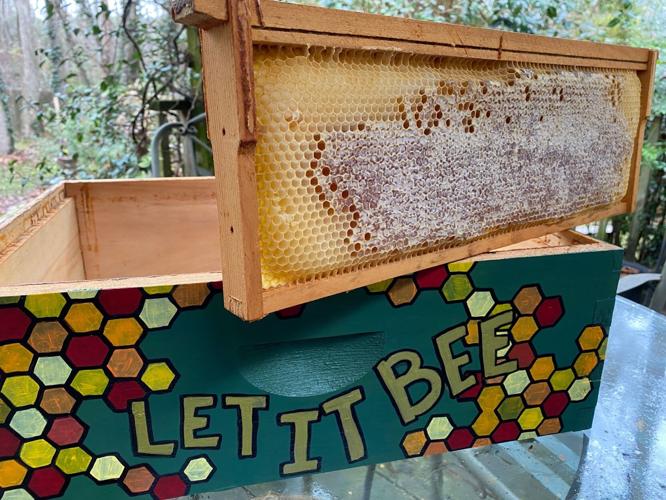Frames from our beehive are in the freezer and full of honey. I put them there a month ago. I thought I put the shallow box in there with the frames. Now the box is gone. I couldn’t remember stacking the frames like that.
You may be wondering why the frames are in the freezer.
Our Langstroth beehive has three boxes. They are open-ended so that, when stacked on top of each other, bees can crawl from the bottom to the top. The bottom one is a deep box where the queen lays eggs. The one in the middle is deep and filled with honey. The box on top is shallow. It is shorter than the deep ones and also filled with honey.

Bees produce honeycomb with glands along their abdomen and use it to build the hexagon-shaped cells. The shape isn’t an accident. A hexagon is structurally sound and the most efficient use of space. Bees are little engineers. These cells are where honey is stored and capped. It’s also where the queen will lay her eggs. Tony Bertauski/provided
When bees collect nectar, it is converted into honey and stored in the hexagonal cells of the honeycomb.
Our bee population has dropped. That’s normal for this time of year due to lower temperatures and fewer flowers. Once spring arrives, the population will rise again. In the meantime, they rely on stored honey for food.
With fewer bees inside the hive, the colony is susceptible to pests. One common problem is small hive beetles. These black insects are about the size of ladybeetles and feed on stores of pollen and nectar, the precious food source bees need for winter. If hive beetles are left unchecked, the bees will look for a new home.
We’ve placed hive beetle traps filled with vinegar and soap inside the hives. When the hive beetles seek shelter inside the traps, the soap strips their cuticles and dries them out. We also put Swiffer mop sheets inside the hive. The beetles get stuck in the fibers and can’t escape.
To help the bees keep warm, we reduced the size of the hive by temporarily removing the shallow box, although it’s also less space for bees to guard against pests. We stored the shallow box frames of honey in the freezer. We’ll put it back in February when spring is right around the corner.
With luck, our bees will once again fill the empty frames with honey. Last year we harvested three gallons, leaving plenty of honey in the beehive. We gave so much away that we ran out. However, we still had plenty of waxy honeycomb from the harvest.
Bees produce honeycomb with glands along their abdomen and use it to build the hexagon-shaped cells. The shape isn’t an accident. A hexagon is structurally sound and the most efficient use of space. Bees are little engineers. These cells are where honey is stored and capped. It’s also where the queen will lay her eggs.

Rendered beeswax is collected on a paper towel. Tony Bertauski/provided
We had scraped the beeswax off the frames when we harvested the honey, then rendered it in an old crockpot. Once it liquified, we added it to yogurt containers with a little water. We ended up with two big blocks of wax.
When we were ready to use it, we broke pieces onto a paper towel that were placed on a 1/4” screen, and then put that over a pan of water. This went into the oven set to 200 degrees. The wax melted through the paper towel and floated on the water. The paper towel filtered out debris, but it was still waxy and made for an excellent fire starter.
We added wicks to small drinking glasses, then added chunks of filtered wax. The glasses were heated in a pan of water until the wax melted. The wicks were trimmed and then, guess what our family got for Christmas?

The beehive frame holds frames that hold honey. Tony Bertauski/provided
By the way, it turns out that I did put the shallow box into the freezer. My family took it out and painted it for Christmas. It was one of the best presents under the tree. The bees are going to love it.
For more information on beekeeping, go to scstatebeekeepers.com or charlestonbees.org. You can also visit Charleston Community Bee Gardens on Facebook.














